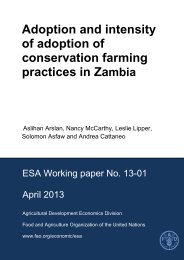Adoption and intensity of adoption of conservation farming practices in Zambia
Adoption and intensity of adoption of conservation farming practices in Zambia
Adoption and intensity of adoption of conservation farming practices in Zambia
Create successful ePaper yourself
Turn your PDF publications into a flip-book with our unique Google optimized e-Paper software.
4.1. <strong>Adoption</strong> <strong>of</strong> CA<br />
4. METHODOLOGY<br />
We model the decision <strong>of</strong> a farmer whether to adopt a practice or not us<strong>in</strong>g the latent variable<br />
approach, where the farmer will adopt the practice that maximizes the returns. The return<br />
function will be based on both production <strong>and</strong> consumption characteristics, because most<br />
farmers operate under various market imperfections that make the consumption <strong>and</strong><br />
production decisions <strong>in</strong>terdependent (non-separable) (de Janvry, Fafchamps, <strong>and</strong> Sadoulet<br />
1991).<br />
Let the latent variable<br />
*<br />
C it be def<strong>in</strong>ed as:<br />
*<br />
Cit = Xitβ + uit + vi<br />
(1)<br />
where X it is a 1 x K vector (with first element equal to unity), β is a K x 1 vector <strong>of</strong><br />
parameters, it u is normally distributed error term <strong>in</strong>dependent <strong>of</strong> it X , <strong>and</strong> vi are time <strong>in</strong>variant<br />
unobserved effects (Wooldridge, 2002, Ch. 15). We only observe an <strong>in</strong>dicator variable it C<br />
that represents farmer i’s decision at time t to adopt CA:<br />
C = C > .<br />
*<br />
it 1[ it 0]<br />
We can express the distribution <strong>of</strong> it C given it X <strong>and</strong> the unobserved effect v i as follows:<br />
PC ( = 1 | X , v) = φ( X β + v), t= 1,..., T<br />
it it i it i<br />
Estimat<strong>in</strong>g the parameters <strong>of</strong> <strong>in</strong>terest us<strong>in</strong>g fixed effects probit analysis treats the unobserved<br />
effects ( v i ) as parameters to be estimated, is computationally difficult <strong>and</strong> subject to<br />
<strong>in</strong>cidental parameters problem. 21 Traditional r<strong>and</strong>om effects probit model requires an<br />
assumption that i v <strong>and</strong> i X are <strong>in</strong>dependent <strong>and</strong> that vi has a normal distribution, i.e.,<br />
v X N σ<br />
2<br />
i | i ~ (0, v)<br />
We can consistently estimate the partial effects <strong>of</strong> the elements <strong>of</strong> X t on the response<br />
probability at the average value <strong>of</strong> i v ( v i =0) us<strong>in</strong>g a conditional maximum likelihood<br />
approach. We use this approach <strong>in</strong> model<strong>in</strong>g the <strong>adoption</strong> decisions.<br />
4.2. Intensity <strong>of</strong> CA <strong>Adoption</strong><br />
We also model the <strong><strong>in</strong>tensity</strong> <strong>of</strong> <strong>adoption</strong> given the fact that most farmers adopt CF only<br />
partially <strong>and</strong> variables that may <strong>in</strong>crease the <strong><strong>in</strong>tensity</strong> <strong>of</strong> <strong>adoption</strong> are relevant for policy<br />
makers. The <strong><strong>in</strong>tensity</strong> <strong>of</strong> <strong>adoption</strong> is def<strong>in</strong>ed as the proportion <strong>of</strong> total cultivated l<strong>and</strong> that is<br />
under the CF <strong>practices</strong> as def<strong>in</strong>ed <strong>in</strong> this paper, hence the dependent variable is bounded by<br />
21<br />
Estimat<strong>in</strong>g v i (N <strong>of</strong> them) along with β leads to <strong>in</strong>consistent estimation <strong>of</strong> β when T is fixed <strong>and</strong> N →∞<br />
(Wooldridge, 2002, p. 484).<br />
14



